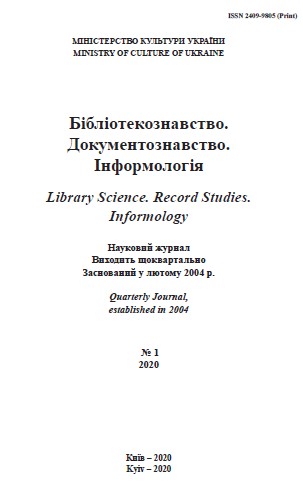РОБСІЛЬКОРІВСЬКИЙ РУХ У СИСТЕМІ ДІЯЛЬНОСТІ БАГАТОТИРАЖНОЇ ПРЕСИ УКРАЇНИ (1920 – ПОЧАТОК 1930-Х РР.)
THE WORKER AND VILLAGE CORRESPONDENTS (ROBSILKOR) MOVEMENT IN THE SYSTEM OF MASS-CIRCULATION PRESS OF UKRAINE (THE 1920S – EARLY 1930S)
Author(s): Olha VakulchukSubject(s): Cultural history, Media studies, Political history, Politics and communication, Interwar Period (1920 - 1939)
Published by: Національна академія керівних кадрів культури і мистецтв
Keywords: worker and village correspondents; Robsilkor movement; Soviet party press; masscirculation and wall newspapers;
Summary/Abstract: The purpose of the article is to characterize the Robsilkor movement as a specific phenomenon of the Soviet era, a kind of social and political movement existing within the Soviet Party press; to determine the place and significance of the movement in the system of mass-circulation press of Ukraine during its formation and development. The methodology is based on the principle of historicism and offers a set of methods to be applied herein, in particular: historical and chronological, analysis of historical sources and synthesis of information. The scientific novelty lies in consideration of the Robsilkor movement as a phenomenon of the Soviet era in the context of the functioning of the grassroots press, in particular, wall and mass-circulation newspapers issued by the industrial enterprises, collective farms, schools, and institutions of Ukraine in the 1920s - early 1930s. Conclusions. The Robsilkor movement was a specific phenomenon of the Soviet era that became widespread and gained public importance thanks to the support of the Soviet Party leadership that trusted workers and village correspondents to shape public opinion. The main feature of the movement was its massiveness as the active majority worked as correspondents «building Soviet socialism» and manifesting Soviet democracy. Despite the fact that the basic principles of the Robsilkor movement were ideologically charged, it had a positive influence on society at that time. Thanks to the opportunity to become a newspaper correspondent, ordinary workers and peasants learned the basics of journalism, increasing their level of education and culture; the most capable of the worker and village correspondents became editors, literary workers. In the context of acute shortage of professional staff, worker and village correspondents became the main contributors to the grassroots press – district, mass-circulation, and wall newspapers. That job required deep awareness of the affairs of a particular production team as well as participation in public life. Awareness of the contribution to the history of media education can also serve as a positive factor that characterizes the Robsilkor movement.
Journal: Бібліотекознавство. Документознавство. Інформологія
- Issue Year: 2020
- Issue No: 4
- Page Range: 71-78
- Page Count: 8
- Language: Ukrainian

